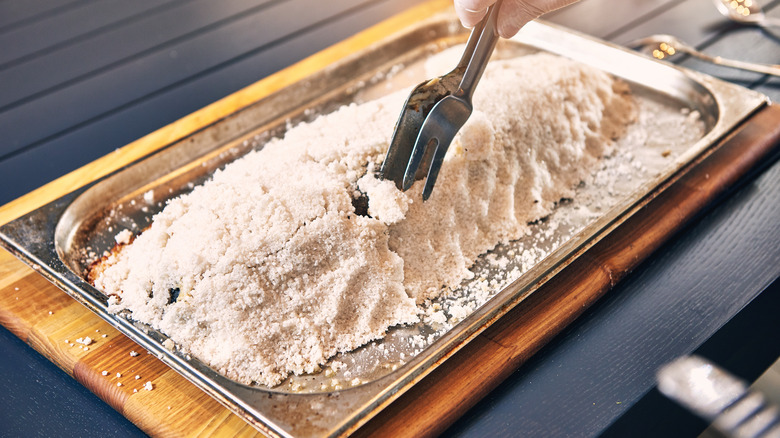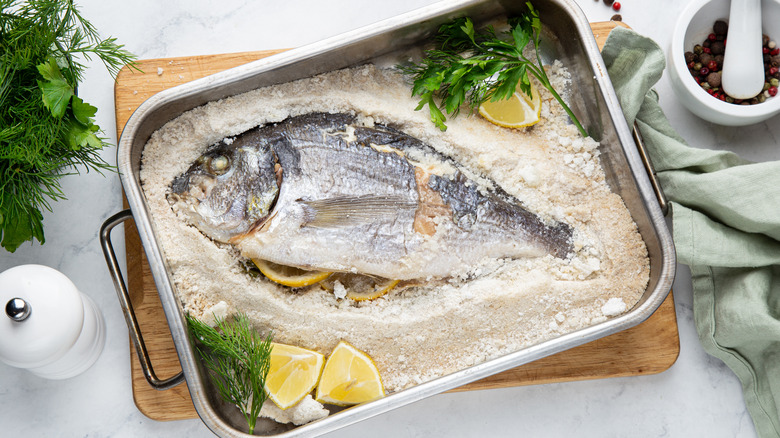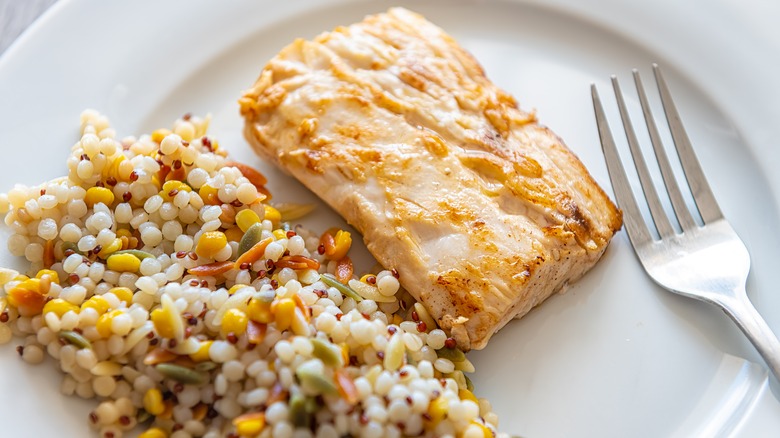The Salt-Crust Method Will Give You The Juiciest Fish Of Your Life
We may receive a commission on purchases made from links.
Fish is an important part of a health diet. Whether you choose fresh water fish or salt water, this type of food provides a good amount of protein, as well as omega-three fatty acids, vitamins D and B2, calcium, iron, zinc, potassium, and iodine, according to the Washington State Department of Health. Plus, when properly prepared, it tastes great for an enjoyable meal.
And that's the key — properly prepared. Everyone has had an overcooked, dried-out piece of fish that is a complete disappointment. That's unfair to you — and the fish. Fish is easy to overcook because it is delicate, has a thin skin, and is low in fat. Additionally, per Exploratorium, the muscle fibers are shorter than those in beef, so it cooks more quickly.
Food writer Harold McGee (per the Washington Post) notes that when that fish is overcooked, the proteins in the flesh over coagulate, and they squeeze out moisture in the flesh. Result: dry fish. The best way to prevent this, as well as shield the delicate flesh from the heat of the oven, is to cook the fish using the salt-crust method.
How to prepare a salt crust
Be warned — you can only use this method with a whole, skin-on fish. If you try to pack a delicate white fish fillet in salt, it will be too heavily salted. You can use this method to cook salmon fillets, which are sturdier, according to noted cookbook author Meike Peters.
Salt not only flavors the fish, but it creates a protective layer between the fish and the heat of the oven, per MasterClass. The fish cooks gently inside the crust, holding in flavor and juices.
So buy a whole fish and get some coarse salt or kosher salt from the market. You'll need a lot of salt. (By the way, when you buy a fresh fish, smell it. It should not smell at all fishy, but instead smell of nothing, or have a briny or sweet aroma, per The American Society for Nutrition.) The fish should be gutted and the fins and gills removed.
Cook and fillet the fish
To keep the crust together, MasterClass says that the salt should be mixed with egg white until it feels like sand. Put a layer about 1/2-inch deep in a baking dish, add your fish, then pat the remaining salt mixture all over the fish. The fish should be completely covered.
Bake the fish at 400 degrees F for about 35 minutes, per Chef José Andres via Food & Wine, then remove it from the oven and let stand for 10 minutes. Now remove the salt crust. You can use a fish spatula or a knife to slice around the fish and lift the crust off, or you can crack the crust and peel it off. Brush off any excess salt. The fish needs to be skinned before you can serve it.
And no, this method doesn't make the fish taste salty, according to Saveur. It will just produce a fish that is the most tender and juicy you have ever eaten.


